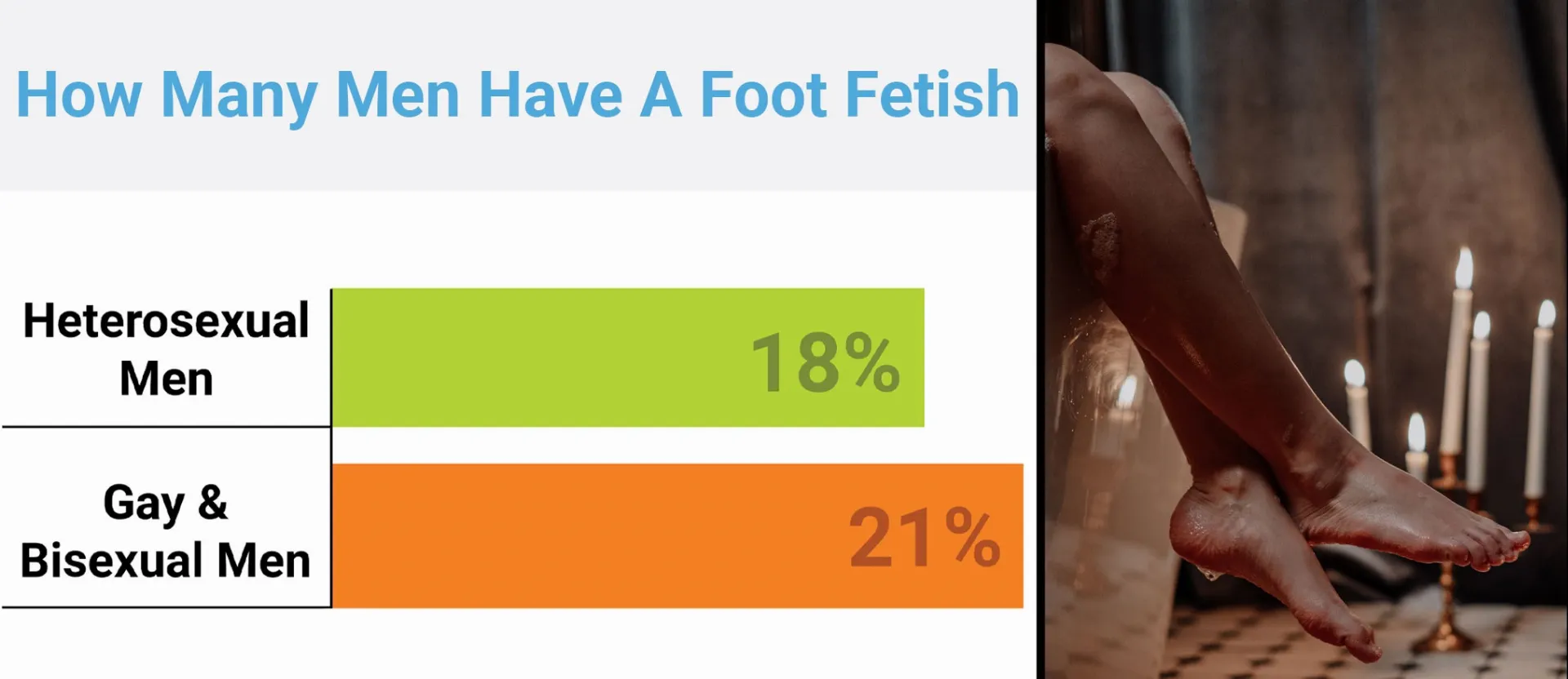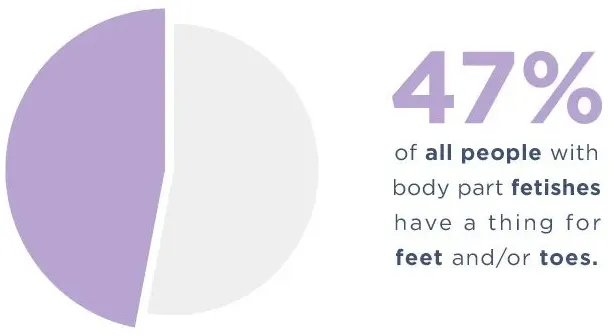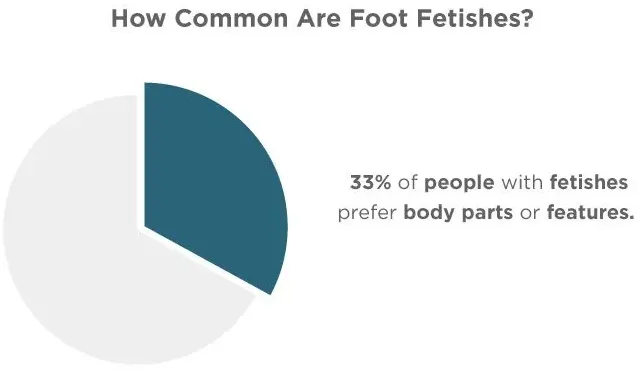How common is a foot fetish?

A foot fetish, also known as podophilia, is actually quite common among individuals. It is estimated that around 10-20% of individuals have a foot fetish to some extent. This means that millions of people worldwide are sexually aroused by feet or find them to be a particularly attractive part of the body.
There are various reasons why someone may develop a foot fetish. It could be due to a past experience or association with feet, cultural influences, or simply a natural preference that has developed over time. Additionally, feet are often considered to be an erogenous zone, so it is not surprising that some people find them to be sexually stimulating.
Despite the prevalence of foot fetishes, many individuals may feel ashamed or embarrassed about their desires due to societal stigma or judgment. However, it is important to remember that sexual preferences are a normal and natural part of human sexuality. As long as it is consensual and does not harm oneself or others, there is nothing wrong with having a foot fetish.
The surprising frequency of foot fetishes among individuals#

Foot fetishes are more common than one might think, with studies showing that around one in every three individuals has some level of interest in feet. This surprising frequency of foot fetishes can be attributed to a variety of factors, including cultural influences, psychological explanations, and evolutionary theories.
Culturally, feet have long been associated with beauty and sensuality in many societies, leading to a heightened interest in them. In some cultures, foot massage and worship are considered acts of devotion and respect, further perpetuating the fetishization of feet.
Psychologically, foot fetishes can be linked to childhood experiences, such as positive reinforcement or traumatic events involving feet. Additionally, feet are often associated with vulnerability and intimacy, which can increase their appeal to individuals seeking a sense of power or control.
Evolutionarily, the feet are a vital part of human anatomy, playing a crucial role in mobility and survival. As such, an attraction to feet may have developed as a way to ensure the selection of a healthy mate with strong, functional feet.
Uncovering the prevalence of foot fetishes in modern culture#
Foot fetishes have been a taboo topic for many years, but recent studies have shown that they are actually quite prevalent in modern culture.
Research has found that foot fetishes are more common in men than women, with approximately 47% of men admitting to having a foot fetish compared to only 23% of women. This could be due to a variety of factors, including societal norms and gender roles that have historically sexualized women's feet.
The prevalence of foot fetishes in modern culture can also be seen in the media, with an increase in the popularity of foot-related content in recent years. From celebrities posting pictures of their feet on social media to the rise of foot fetish websites and forums, it is clear that the fascination with feet is becoming more mainstream.
Additionally, the fashion industry has played a role in normalizing foot fetishes, with the popularity of high heels and sandals that accentuate the feet. This has led to an increase in foot-focused advertising and marketing campaigns, further perpetuating the fetishization of feet in society.
Overall, the prevalence of foot fetishes in modern culture is undeniable, and it is important to continue to have open and honest conversations about this topic to reduce stigma and promote understanding.
How common is it to have a foot fetish?#

A foot fetish is actually quite common, with studies showing that it is one of the most common fetishes among individuals. Research has suggested that around 47% of all fetishes are related to feet, making it a prevalent sexual interest for many people.
There are a variety of possible reasons for the prevalence of foot fetishes. Some experts believe that because feet are often covered and considered taboo in society, they become a forbidden fruit that some individuals find particularly alluring. Others suggest that feet are a focal point during sexual encounters, making them a natural object of desire for some.
It is important to note that having a foot fetish is not necessarily a sign of abnormality or deviance. Fetishes are a normal and healthy part of human sexuality, and as long as they are consensual and do not harm others, they are nothing to be ashamed of.
Overall, the prevalence of foot fetishes highlights the diversity of human sexuality and the wide range of desires that individuals may have. It is important for individuals to feel comfortable exploring their own sexual interests and preferences, as long as they are safe, consensual, and respectful.
Understanding the prevalence of foot fetishes worldwide#
Foot fetishism, also known as podophilia, is a sexual interest in feet. It is one of the most common fetishes, with estimates suggesting that it affects around 10% of the population worldwide. However, the prevalence of foot fetishes can vary greatly depending on culture, upbringing, and individual experiences.
In some cultures, feet are considered highly erotic and are often the focus of sexual desire. For example, in Japan, foot fetishism is relatively common due to the traditional practice of removing shoes before entering a home, which makes feet more visible and accessible. On the other hand, in Western cultures, feet are often seen as dirty or unattractive, which may lead to a lower prevalence of foot fetishes.
Understanding the prevalence of foot fetishes worldwide can help researchers and healthcare professionals better address the needs of individuals with this sexual interest. By studying the factors that contribute to the development of foot fetishes, such as childhood experiences or cultural influences, we can gain a better understanding of this phenomenon and provide appropriate support and resources for those who may be struggling with their fetish.
The prevalence of foot fetishes in different demographics#
Foot fetishes are a common but often misunderstood sexual preference that involves a strong attraction to feet. While foot fetishes can be found in individuals of all genders, ages, and backgrounds, research suggests that certain demographics may be more likely to have this particular fetish.
Studies have shown that foot fetishes are more prevalent in men than in women, with some estimates suggesting that up to 47% of men have a foot fetish compared to only 4% of women. Additionally, foot fetishes are more common among younger individuals, with one study finding that 23% of people aged 18-24 reported having a foot fetish.
Cultural factors may also play a role in the prevalence of foot fetishes in different demographics. For example, in some cultures, feet are considered highly sexualized and fetishized, which may contribute to a higher prevalence of foot fetishes in those populations.
Examining the frequency of foot fetishes in relationships#
Foot fetishes are a common and often misunderstood sexual preference. While some may find it unusual or even taboo, research suggests that foot fetishes are actually quite prevalent in relationships.
Studies have shown that a significant number of individuals have a preference for feet when it comes to arousal and sexual satisfaction. In fact, foot fetishes are one of the most common fetishes among adults.
When it comes to relationships, the frequency of foot fetishes can vary. Some couples may find that they share a mutual interest in feet and incorporate it into their sexual activities. Others may find that one partner has a foot fetish while the other does not, which can create challenges in the relationship.
Communication is key when it comes to navigating foot fetishes in relationships. It is important for both partners to openly discuss their preferences and boundaries to ensure that both parties feel comfortable and respected.
Overall, the frequency of foot fetishes in relationships is more common than one might think. As long as both partners are open and understanding, foot fetishes can be integrated into a healthy and fulfilling sexual relationship.
The prevalence of foot fetishes in popular media#
Foot fetishes have long been a popular topic in popular media, with numerous references in movies, TV shows, and even music. From Quentin Tarantino's infamous foot fetish scenes in films like "Pulp Fiction" to celebrities like Quentin Tarantino being known for their love of feet, it's clear that this particular kink has a widespread appeal.
One of the most well-known examples of foot fetishism in popular media is the character of Rex in the TV show "30 Rock," who is portrayed as having an intense fascination with feet. This character's obsession with feet is played for laughs, but it also serves as a reminder of the prevalence of foot fetishes in the real world.
In music, artists like Rihanna have incorporated references to foot fetishes in their lyrics, further cementing the idea that this kink is not as taboo as some may think. Additionally, social media platforms like Instagram have given rise to a new wave of foot fetishism, with accounts dedicated to showcasing and admiring feet becoming increasingly popular.
Overall, the prevalence of foot fetishes in popular media serves as a reminder that sexual preferences are diverse and varied, and that there is nothing inherently wrong or deviant about having a particular fetish.
Dispelling myths about the rarity of foot fetishes#
Foot fetishes are often portrayed as rare and unusual, leading to misconceptions and stigma surrounding those who have this particular sexual interest. However, the reality is that foot fetishes are actually quite common and more prevalent than one might think.
Research has shown that foot fetishes are one of the most common types of fetishes, with studies estimating that up to 47% of individuals have some level of interest in feet. This suggests that foot fetishes are not as rare as society may lead us to believe.
There are several factors that may contribute to the prevalence of foot fetishes. For some individuals, feet are considered an erogenous zone and can be a source of sexual arousal. Others may find feet aesthetically pleasing or enjoy the tactile sensations that come with foot play. Additionally, cultural influences and media representations of foot fetishes can also play a role in shaping individuals' interests and desires.
It is important to dispel the myths surrounding foot fetishes and recognize that they are a normal and healthy aspect of human sexuality. As long as all parties involved are consenting and comfortable, there is no shame in exploring and embracing one's sexual preferences, including those related to feet.
What research reveals about the commonality of foot fetishes#
Research on foot fetishes has revealed that they are actually quite common, with estimates suggesting that between 20-30% of the population may have some level of interest in feet. This phenomenon crosses gender, age, and cultural boundaries, showing that foot fetishes are not limited to any specific group of people.
One study conducted by researchers at the University of Bologna found that individuals with foot fetishes often have heightened sensitivities in their brain's somatosensory cortex, which is responsible for processing sensory information. This may explain why some people find feet to be particularly arousing or pleasurable.
Additionally, research has shown that foot fetishes are often linked to other fetishes and kinks, such as BDSM or role-playing. This suggests that individuals with foot fetishes may have a broader range of sexual interests and desires.
Overall, research on foot fetishes indicates that they are a normal and common aspect of human sexuality. While some may still view foot fetishes as taboo or unusual, studies have shown that they are a natural and healthy expression of sexual desire for many individuals.